Fuzzy Stochastic Unit Commitment Model with Wind Power and Demand Response under Conditional Value-At-Risk Assessment
Abstract
:1. Introduction
- (1)
- The formulation of FSCVaR assessment can accommodate complicated uncertainties. Thus, the operational risk, considering stochastic wind power and fuzzy PEL, is evaluated by FSCVaR.
- (2)
- The FSCCGP is introduced to transfer the traditional FSCCGP to a deterministic equivalent, which mitigates the complexity of the UC model and contributes to high solution efficiency and transparency.
- (3)
- The PGP is proposed to consider the priorities of different goals and generate the tradeoff between reliability requirements and economic goals.
2. The FSCVaR Based on FSCCGP
2.1. FSCVaR Theory
2.2. The Deterministic Equivalent of FSCVaR by CCGP
3. The Uncertainty Factors in the Grid and the Corresponding Reserve Constraints
3.1. The Uncertainty from Wind Power and DR
3.1.1. The Fuzziness of DR
3.1.2. The Stochasticity of Wind Power
3.2. FSCVaR Based on System Reserve Shortage
4. The Three-Stage UC Model Based on PGP
4.1. The Objective Functions of the Model
4.2. Constraints of the UC Model
- Power balance constraint:where is the output of thermal unit and is the on-off status of the thermal unit.
- Unit reserve constraintswhere and are the maximum output and the minimum output of the thermal unit, respectively.
- Ramping constraints:where and are the maximum output and the minimum output of the thermal unit, respectively.
- Minimum shut-up and shut-down time constraints:where and are the minimum shut-up time and the minimum shut-down time, respectively.
4.3. The Three-Stage UC Model Based on PGP
5. Case Sudy
5.1. Risk Criterions Analysis
5.2. Computational Performance
5.3. The Analysis of the Priorities of the Objective Goals
5.4. Sensitive Analysis
6. Conclusions
- (1)
- Compared with the value-at-risk, the unit commitment model based on the conditional value-at-risk amplifies the required reserves to cater the minimization of the complicated uncertainty. The results of the risk criterions experiment indicate that the unit commitment model with conditional value-at-risk as the risk assessment can hedge against the operational risk and meet the system reliability requirement.
- (2)
- In comparison with the traditional linear programming to solve the CVaR, CVaR can be transferred to a deterministic equivalent by introducing CCGP in the proposed model. High solution efficiency and transparency have been ensured, which is supported by the simulation results of the computational performance.
- (3)
- The reserve capacities of the scheduling vary with the different priorities of the different objective functions. In the proposed unit commitment model based on preemptive goal programming, the load shedding risk is minimized preferentially, and the system reliability has the priority over the economic goal, which is supported by the analysis of the priorities of the objective goals.
Acknowledgments
Author Contributions
Conflicts of Interest
Abbreviations
| DR | Demand response |
| VaR | Value-at-risk |
| CVaR | Conditional value-at-risk |
| FSCVaR | Fuzzy stochastic conditional value-at-risk |
| CCP | Chance-constrained programming |
| CCGP | Chance-constraied goal programming |
| FSCCGP | Fuzzy stochastic chance-constrained goal programming |
| UC | Unit commitment |
| PGP | Preemptive goal programming |
References
- Baños, R.; Manzano-Agugliaro, F.; Montoya, F.G.; Alcayde, A.; Gomez, J. Optimization methods applied to renewable and sustainable energy: A review. Renew. Sustain. Energy Rev. 2011, 15, 1753–1766. [Google Scholar] [CrossRef]
- Yang, H.; Jiang, Z.; Lu, H. A hybrid wind speed forecasting system based on a ‘decomposition and ensemble’ strategy and fuzzy time series. Energies 2017, 10, 1422. [Google Scholar] [CrossRef]
- Montoya, F.G.; Manzano-Agugliaro, F.; López-Márquez, S.; Hernández-Escobedo, Q.; Gil, C. Wind turbine selection for wind farm layout using multi-objective evolutionary algorithms. Expert Syst. Appl. 2014, 41, 6585–6595. [Google Scholar] [CrossRef]
- Chong, C.; Ni, W.; Ma, L.; Liu, P.; Li, Z. The use of energy in Malaysia: Tracing energy flows from primary source to end use. Energies 2015, 8, 2828–2866. [Google Scholar] [CrossRef]
- Lowery, C.; O’Malley, M. Impact of wind forecast error statistics upon unit commitment. IEEE Trans. Sustain. Energy 2012, 3, 760–768. [Google Scholar] [CrossRef]
- Ahlstrom, M.; Bartlett, D.; Collier, C.; Duchesne, J.; Edelson, D.; Gesino, A.; Keyser, M.; Maggio, D.; Milligan, M.; Mohrlen, C.; et al. Knowledge is power: Efficiently integrating wind energy and wind forecasts. IEEE Power Energy Mag. 2013, 11, 45–52. [Google Scholar] [CrossRef]
- Tuohy, A.; Meibom, P.; Denny, E.; O’Malley, M. Unit Commitment for Systems with Significant Wind Penetration. IEEE Trans. Power Syst. 2009, 24, 592–601. [Google Scholar] [CrossRef] [Green Version]
- Morales-España, G.; Baldick, R.; García-González, J.; Ramos, A. Power-capacity and ramp-capability reserves for wind integration in power-based UC. IEEE Trans. Sustain. Energy 2016, 7, 614–624. [Google Scholar] [CrossRef]
- Wu, H.; Krad, I.; Florita, A.; Hodge, B.M.; Ibanez, E.; Zhang, J.; Ela, E. Stochastic multi-timescale power system operations with variable wind generation. IEEE Trans. Power Syst. 2017, 32, 3325–3337. [Google Scholar] [CrossRef]
- Wang, Q.; Guan, Y.; Wang, J. A chance-constrained two-stage stochastic program for unit commitment with uncertain wind power output. IEEE Trans. Power Syst. 2012, 27, 206–215. [Google Scholar] [CrossRef]
- Pozo, D.; Contreras, J. A chance-constrained unit commitment with an n-K security criterion and significant wind generation. IEEE Trans. Power Syst. 2013, 28, 2842–2851. [Google Scholar] [CrossRef]
- Wang, Y.; Zhao, S.; Zhou, Z.; Botterud, A.; Xu, Y.; Chen, R. Risk adjustable day ahead unit commitment with wind power based on chance constrained goal programming. IEEE Trans. Sustain. Energy 2017, 8, 530–541. [Google Scholar] [CrossRef]
- Duan, C.; Jiang, L.; Fang, W.; Liu, J. Data-driven affinely adjustable distributionally robust unit commitment. IEEE Trans. Power Syst. 2017, PP. [Google Scholar] [CrossRef]
- Yang, J.; Zhang, N.; Kang, C.; Xia, Q. Effect of natural gas flow dynamics in robust generation scheduling under wind uncertainty. IEEE Trans. Power Syst. 2017, PP. [Google Scholar] [CrossRef]
- Jiang, R.; Wang, J.; Guan, Y. Robust unit commitment with wind power and pumped storage hydro. IEEE Trans. Power Syst. 2012, 27, 800–810. [Google Scholar] [CrossRef]
- Matos, M.A.; Bessa, R.J. Setting the operating reserve using probabilistic wind power forecasts. IEEE Trans. Power Syst. 2011, 26, 594–603. [Google Scholar] [CrossRef]
- Xiong, P.; Jirutitijaroen, P. A stochastic optimization formulation of unit commitment with reliability constraints. IEEE Trans. Smart Grid 2013, 4, 2200–2208. [Google Scholar] [CrossRef]
- Zhang, Y.; Giannakis, G.B. Distributed Stochastic Market Clearing With High-Penetration Wind Power. IEEE Trans. Power Syst. 2015, 31, 895–906. [Google Scholar] [CrossRef]
- Wang, B.; Liu, X.; Zhu, F.; Hu, X.; Ji, W.; Yang, S.; Wang, K.; Feng, S. Unit commitment model considering flexible scheduling of demand response for high wind integration. Energies 2015, 8, 13688–13709. [Google Scholar] [CrossRef]
- Mortensen, R.E.; Haggerty, K.P. A stochastic computer model for heating and cooling loads. IEEE Trans. Power Syst. 1988, 3, 1213–1219. [Google Scholar] [CrossRef]
- Wang, Q.; Wang, J.; Guan, Y. Stochastic unit commitment with uncertain demand response. IEEE Trans. Power Syst. 2013, 28, 562–563. [Google Scholar] [CrossRef]
- Zhao, C.; Wang, J.; Watson, J.P.; Guan, Y. Multi-stage robust unit commitment considering wind and demand response uncertainties. IEEE Trans. Power Syst. 2013, 28, 2708–2717. [Google Scholar] [CrossRef]
- Yang, S.; Zeng, D.; Ding, H.; Yao, W.; Wang, K.; Li, Y. Multi-Objective Demand Response Model Considering the Probabilistic Characteristic of Price Elastic Load. Energies 2016, 9, 80. [Google Scholar] [CrossRef]
- Zhen, W.; Bian, Q.Y.; Xin, H.H.; Gan, D.Q. A distributionally robust co-ordinated reserve scheduling model considering CVaR-based wind power reserve requirements. IEEE Trans. Power Syst. 2016, 7, 625–635. [Google Scholar]
- Paterakis, N.G.; de la Nieta, A.A.S.; Bakirtzis, A.G.; Contreras, J.; Catalao, J.P. Effect of risk aversion on reserve procurement with flexible demand side resources from the ISO point of view. IEEE Trans. Sustain. Energy 2017, 8, 1040–1050. [Google Scholar] [CrossRef]
- Asensio, M.; Contreras, J. Stochastic unit commitment in isolated systems with renewable penetration under CVaR assessment. IEEE Trans. Smart Grid 2015, 7, 1356–1367. [Google Scholar] [CrossRef]
- Li, L.; Li, J.; Qin, Q.; Cheng, S. Credibilistic conditional value at risk under fuzzy environment. In Proceedings of the 2013 Sixth International Conference on Advanced Computational Intelligence, Hangzhou, China, 19–21 October 2013. [Google Scholar]
- Contini, B. A stochastic approach to goal programming. Oper. Res. 1968, 16, 576–586. [Google Scholar] [CrossRef]
- Hernandez-Escobedo, Q.; Manzano-Agugliaro, F.; Gazquez-Parra, J.A.; Zapata-Sierra, A. Is the wind a periodical phenomenon? The case of Mexico. Renew. Sustain. Energy Rev. 2011, 15, 721–728. [Google Scholar] [CrossRef]
- Hernandez-Escobedo, Q.; Manzano-Agugliaro, F.; Zapata-Sierra, A. Wind strenght description in the province of Almeria. DYNA 2009, 84, 681–686. [Google Scholar]
- Ortega-Vazquez, M.A.; Kirschen, D.S. Estimating the spinning reserve requirements in systems with significant wind power generation penetration. IEEE Trans. Power Syst. 2009, 24, 114–124. [Google Scholar] [CrossRef]
- Winston, W.L. Operations Research: Applications and Algorithms; Duxbury Press: Pacific Grove, CA, USA, 2003. [Google Scholar]
- Generator Data. Available online: http://sys.elec.kitami-it.ac.jp/ueda/demo/WebPF/39-New-England.pdf (accessed on 1 April 2015).
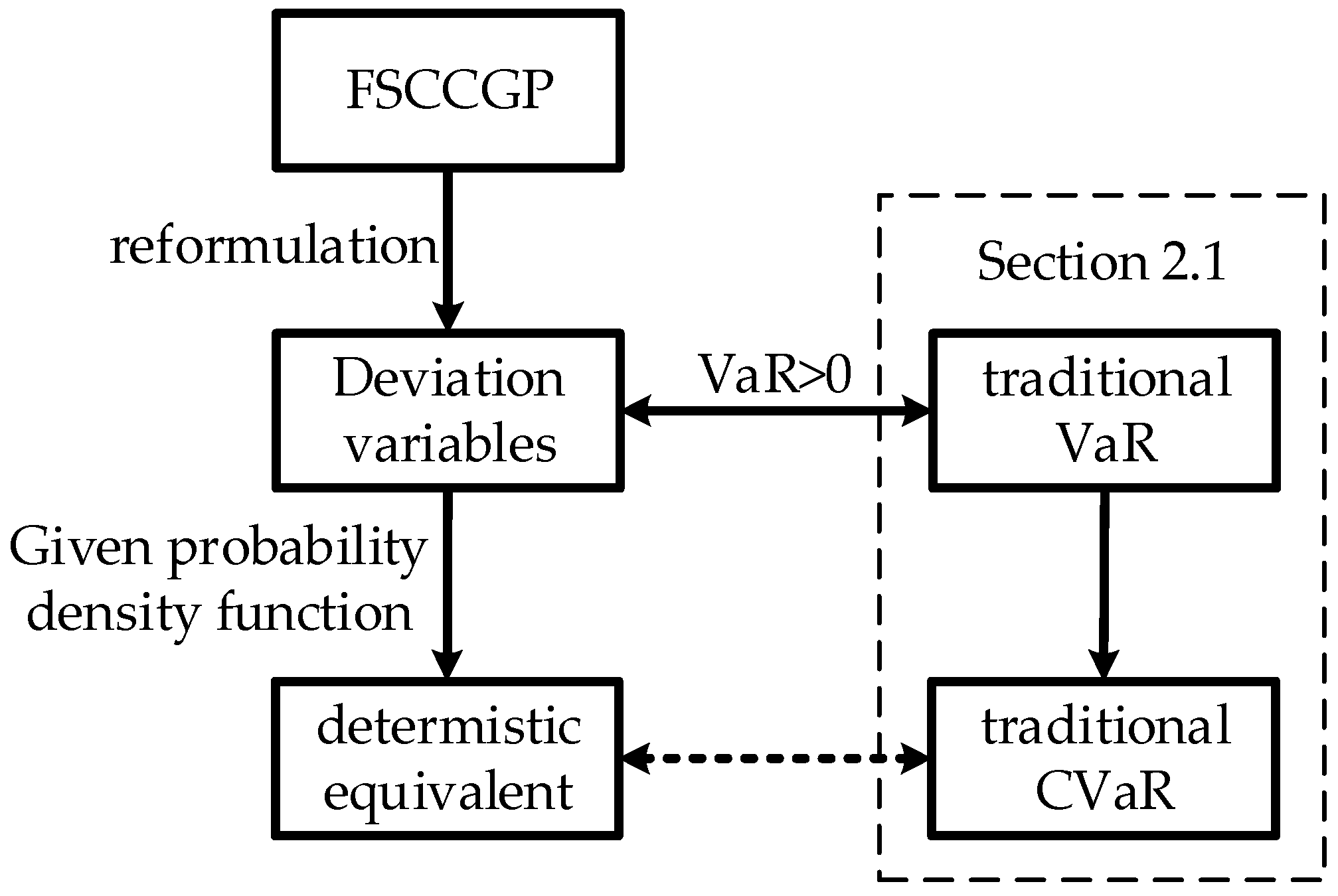
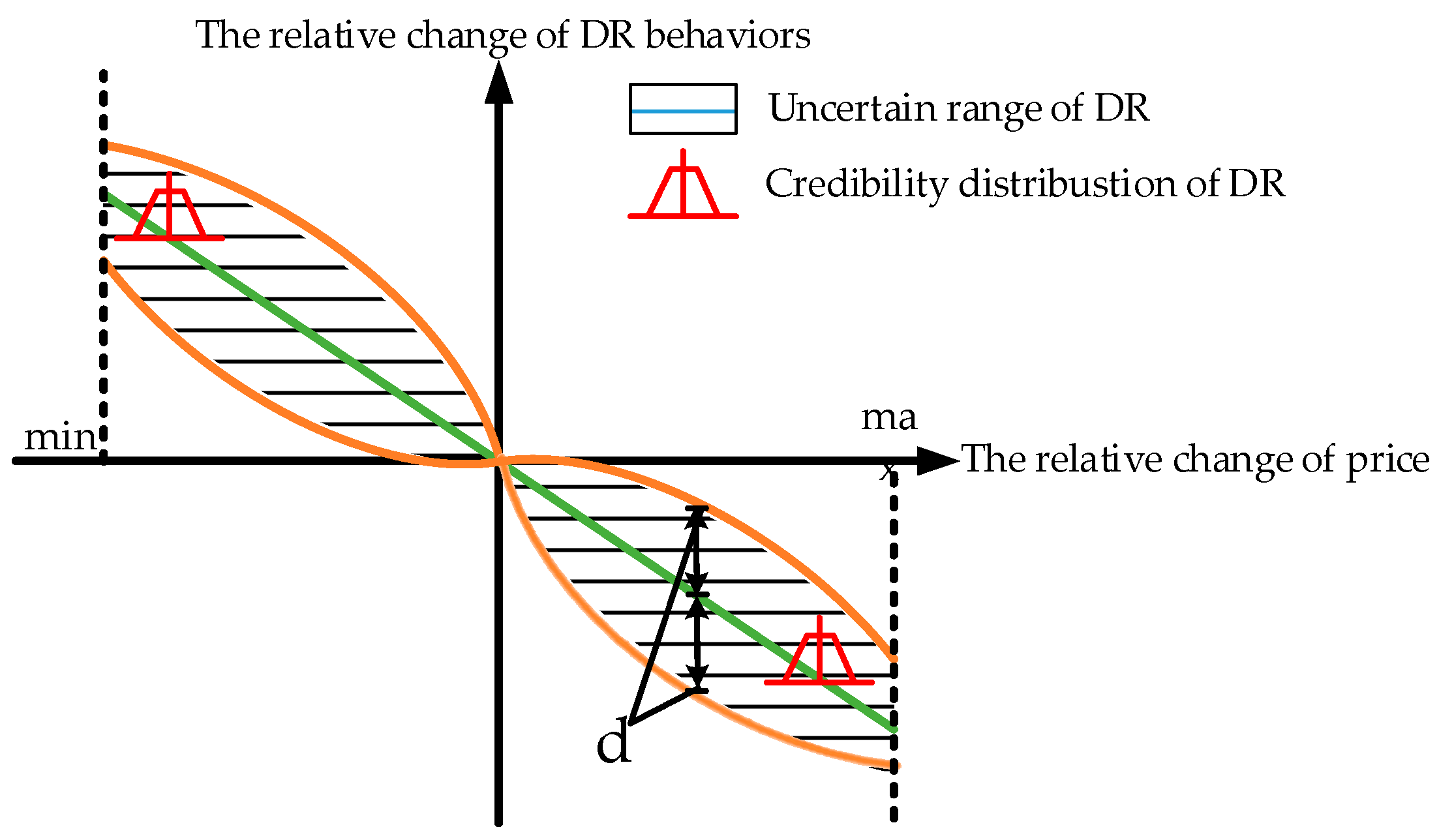
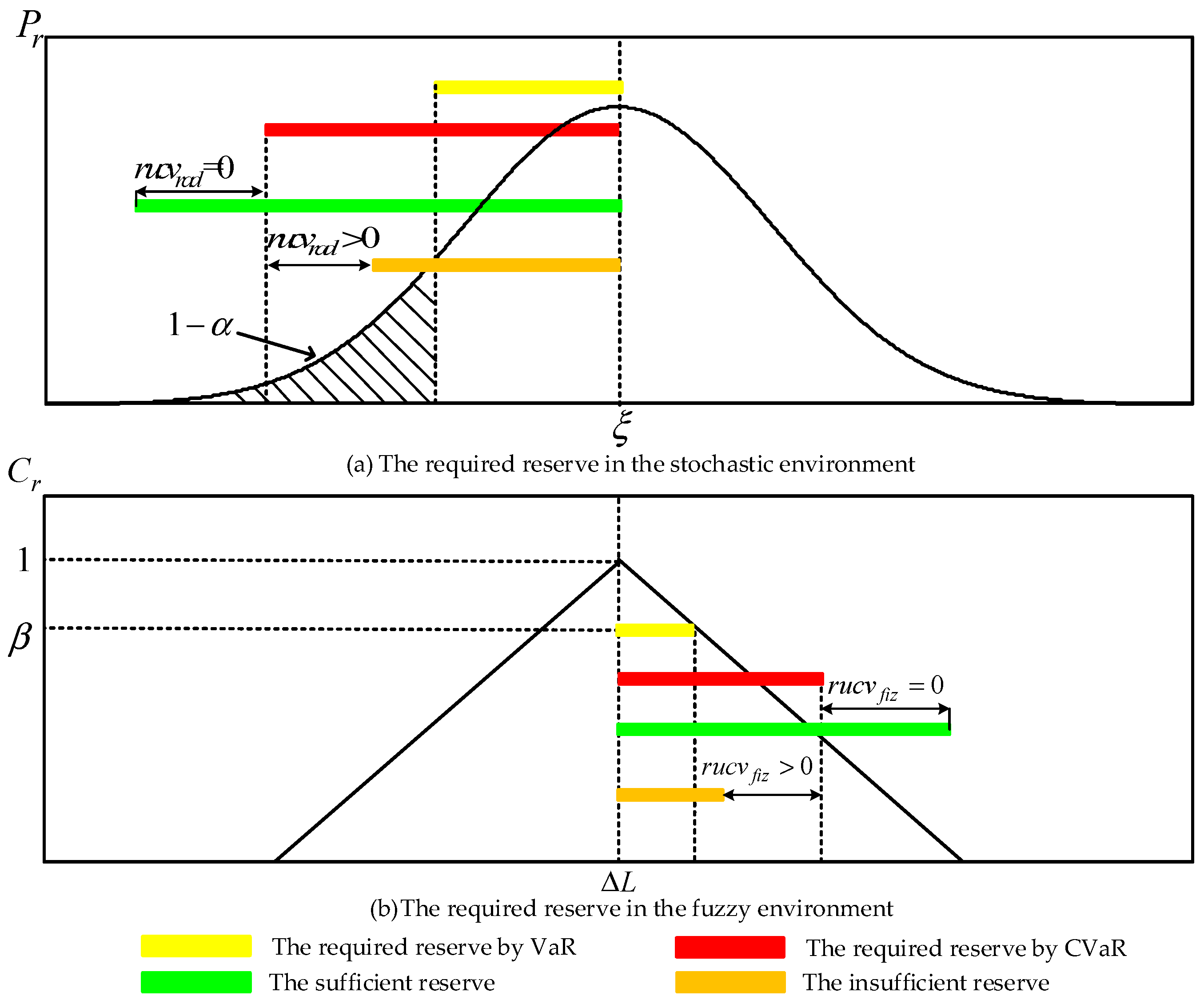
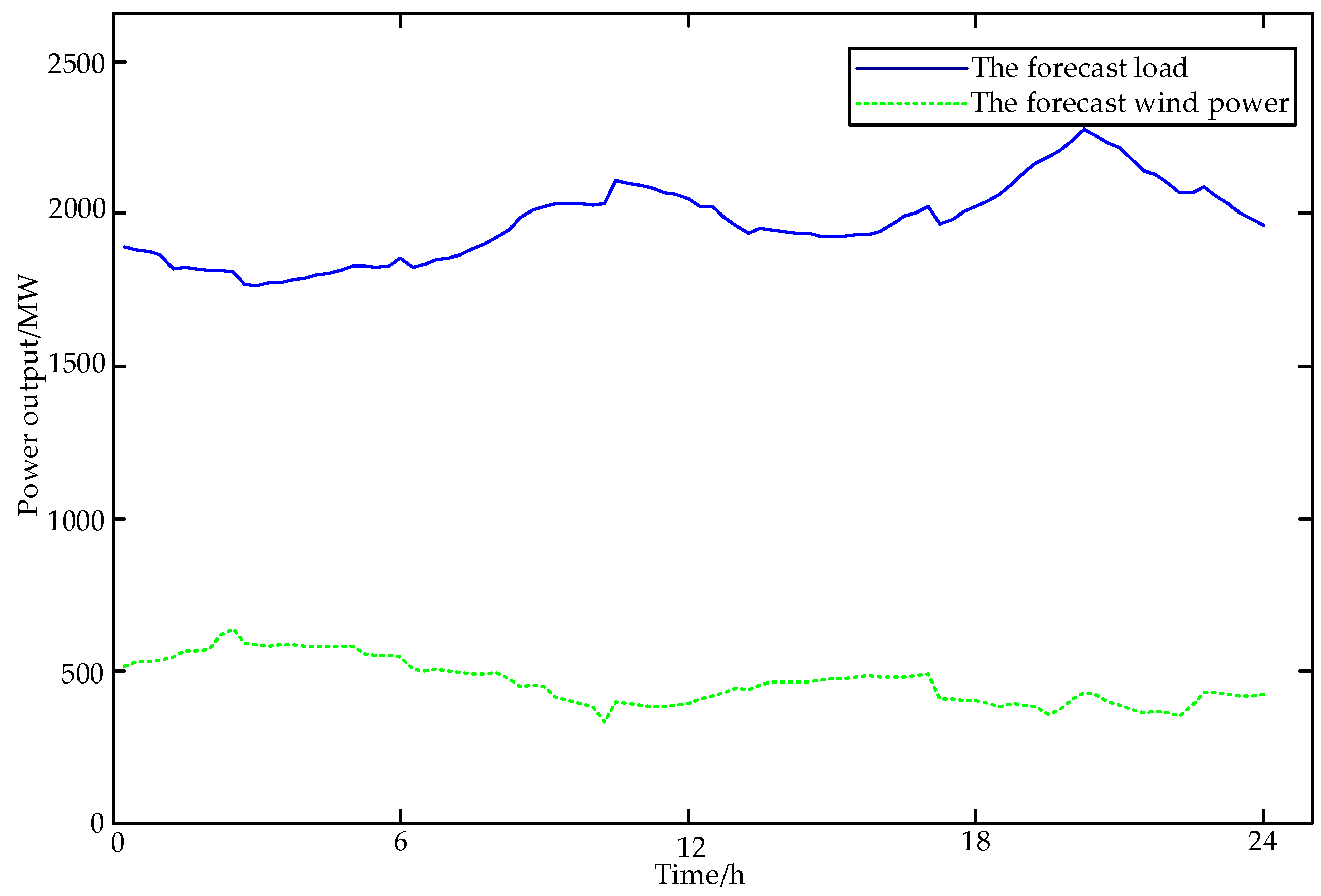
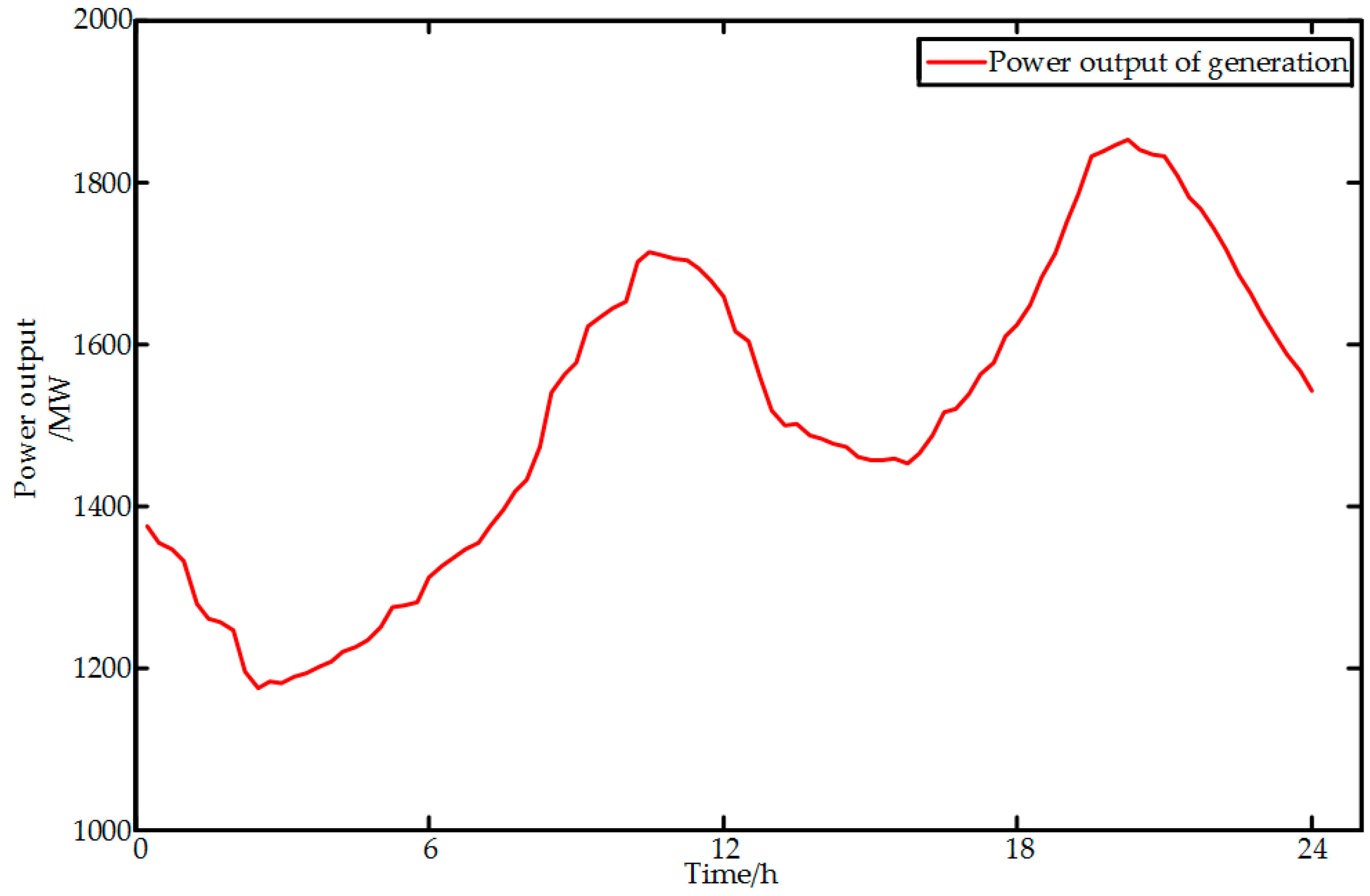
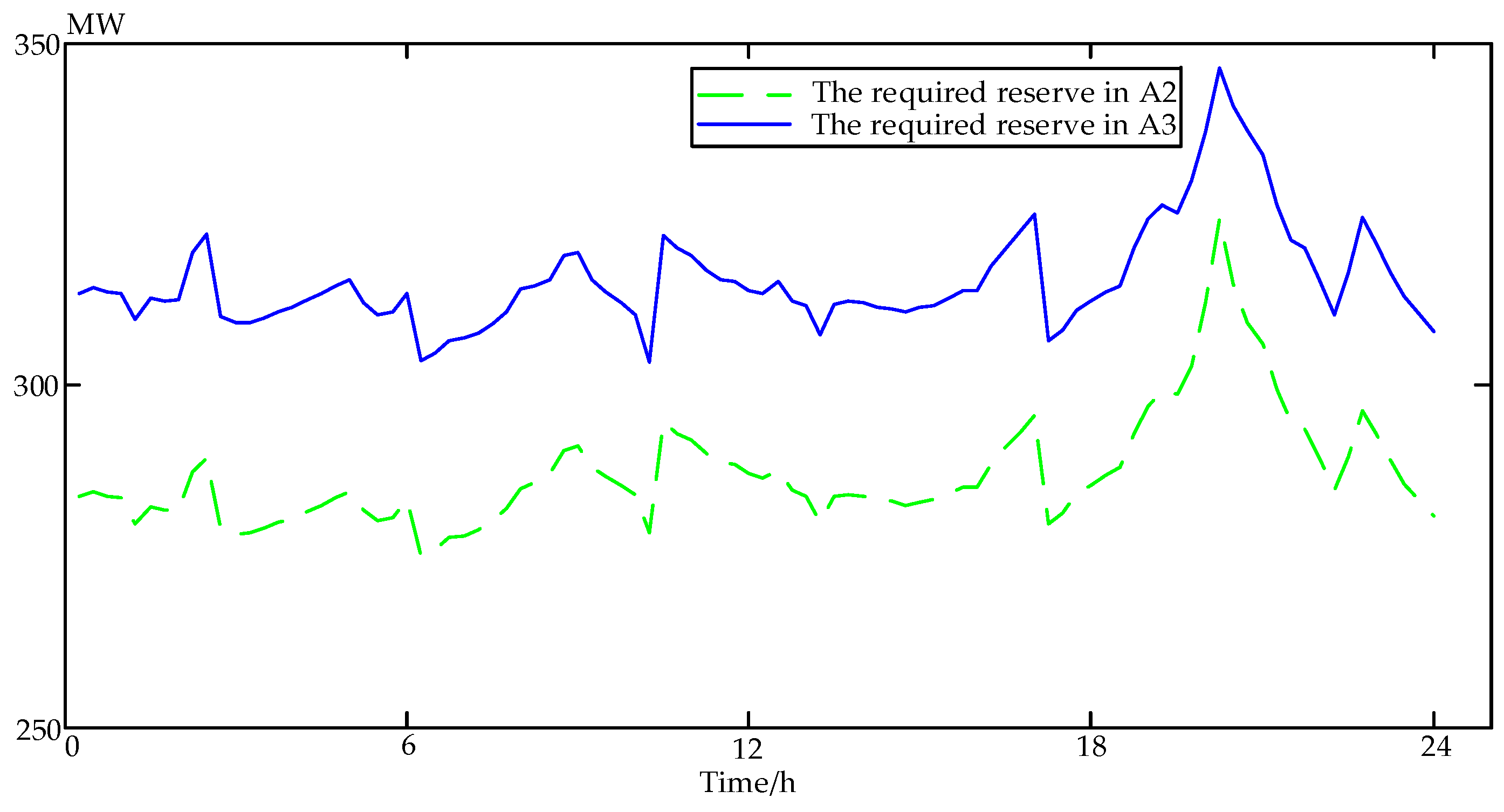
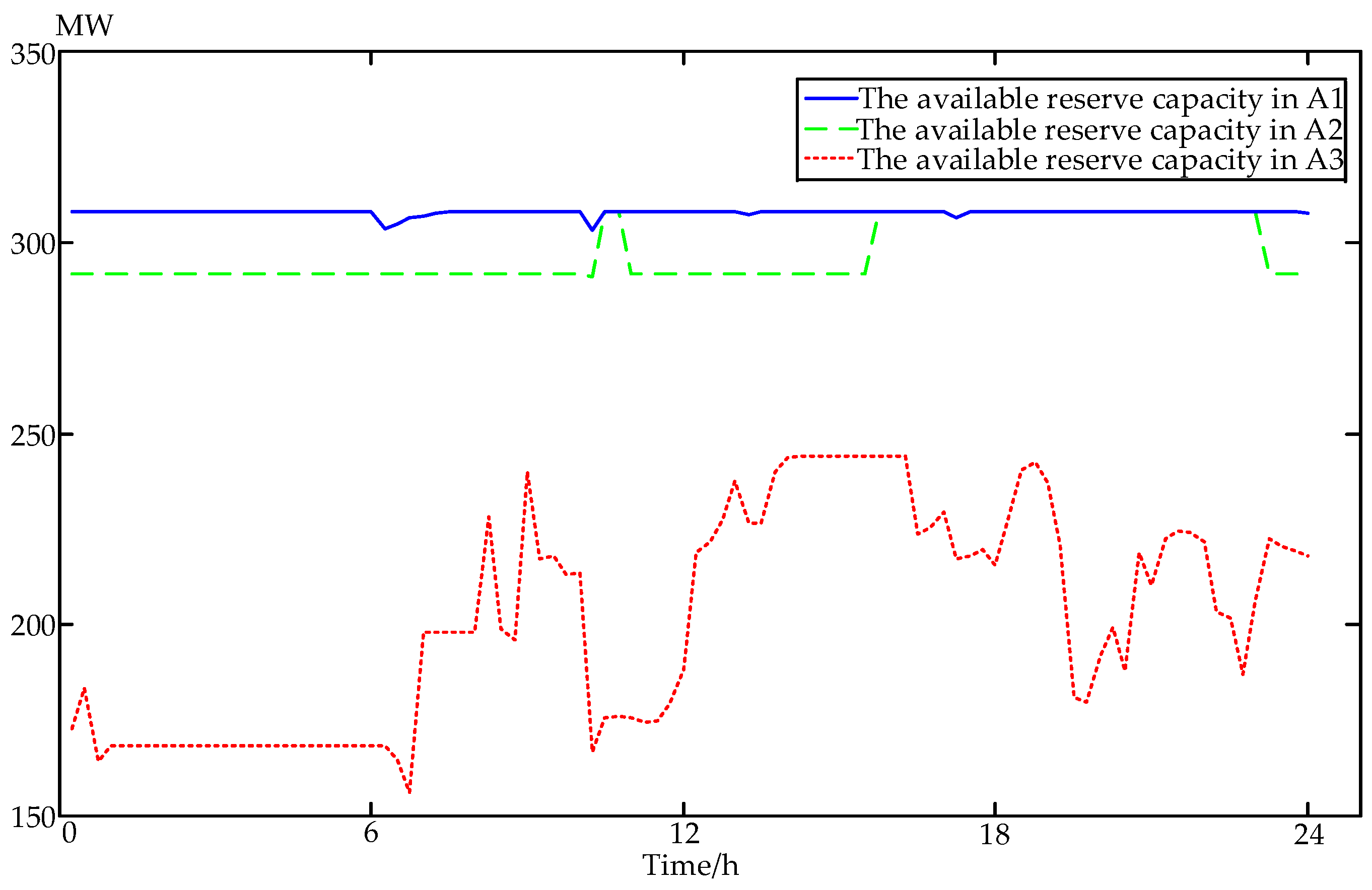
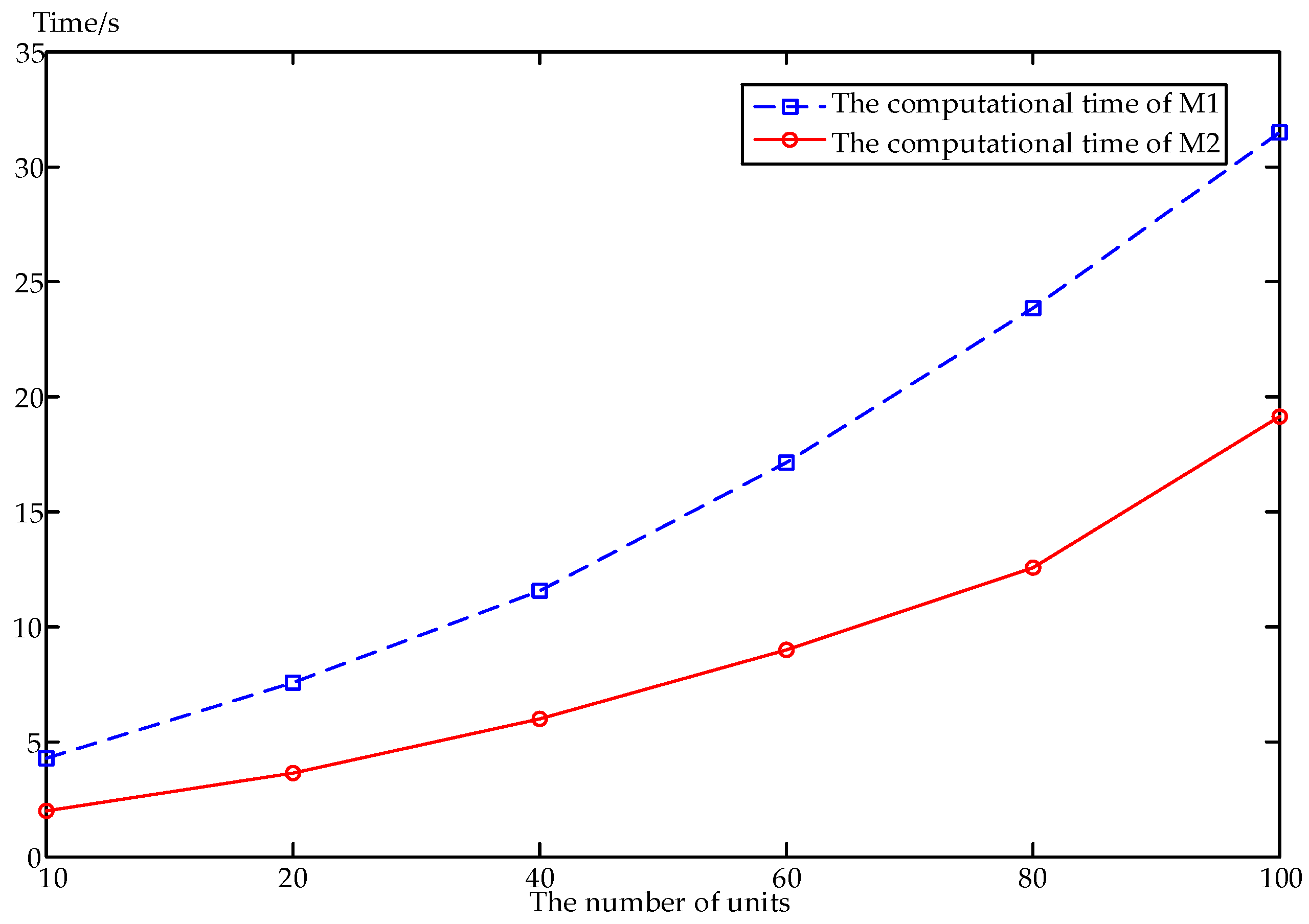
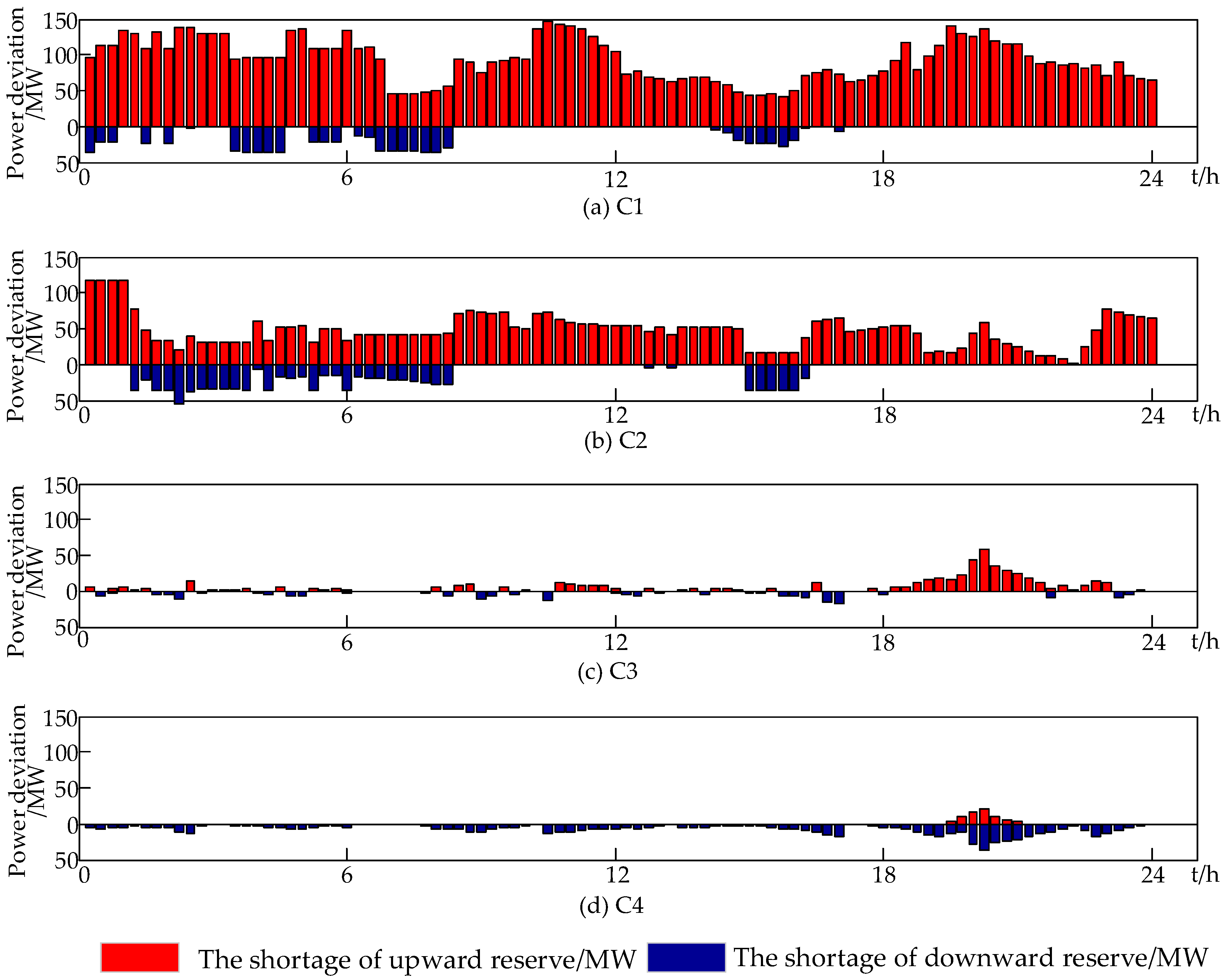

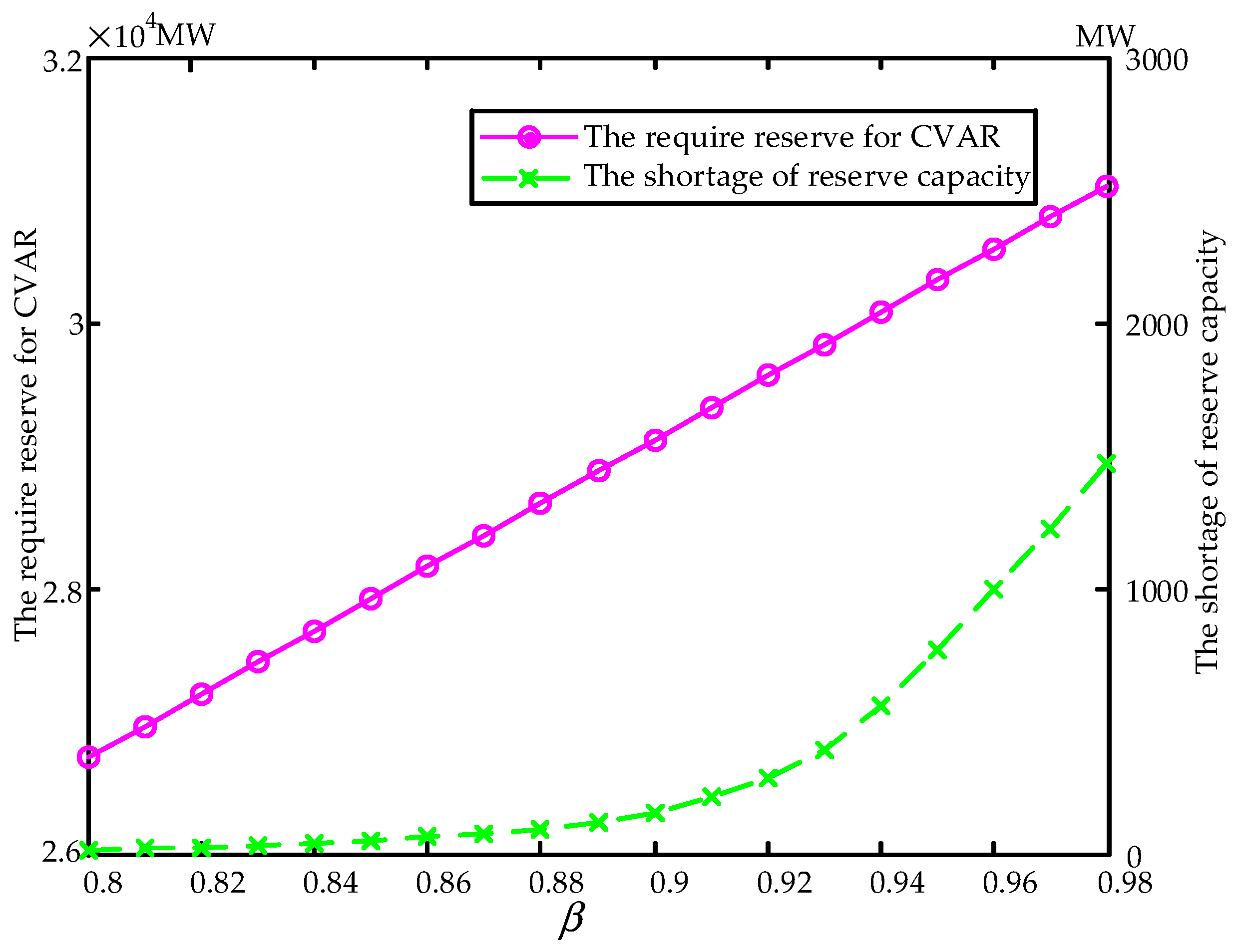
© 2018 by the authors. Licensee MDPI, Basel, Switzerland. This article is an open access article distributed under the terms and conditions of the Creative Commons Attribution (CC BY) license (http://creativecommons.org/licenses/by/4.0/).
Share and Cite
Yin, J.; Zhao, D. Fuzzy Stochastic Unit Commitment Model with Wind Power and Demand Response under Conditional Value-At-Risk Assessment. Energies 2018, 11, 341. https://doi.org/10.3390/en11020341
Yin J, Zhao D. Fuzzy Stochastic Unit Commitment Model with Wind Power and Demand Response under Conditional Value-At-Risk Assessment. Energies. 2018; 11(2):341. https://doi.org/10.3390/en11020341
Chicago/Turabian StyleYin, Jiafu, and Dongmei Zhao. 2018. "Fuzzy Stochastic Unit Commitment Model with Wind Power and Demand Response under Conditional Value-At-Risk Assessment" Energies 11, no. 2: 341. https://doi.org/10.3390/en11020341
APA StyleYin, J., & Zhao, D. (2018). Fuzzy Stochastic Unit Commitment Model with Wind Power and Demand Response under Conditional Value-At-Risk Assessment. Energies, 11(2), 341. https://doi.org/10.3390/en11020341




